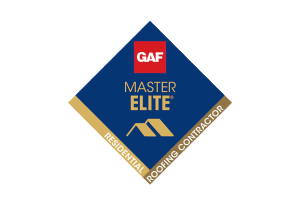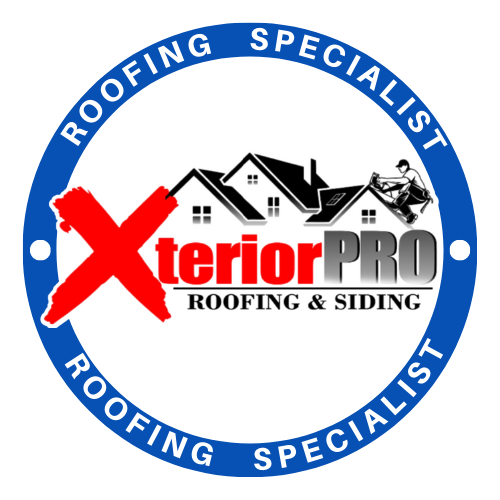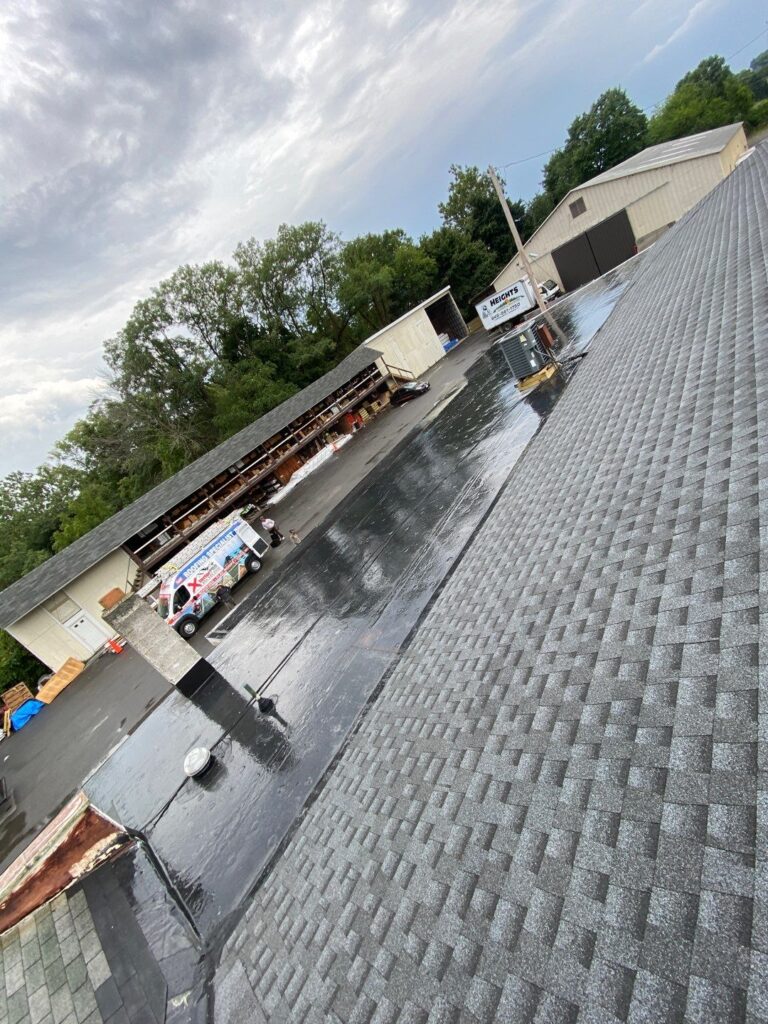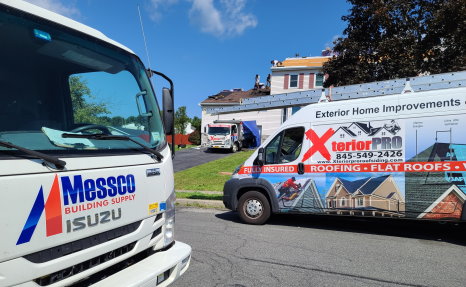


The True Cost of Neglect: How Regular Roof Maintenance Saves Commercial Properties Thousands
24 Hour Service • Financing Options • GAF Certified
Quick Estimate Request
The True Cost of Neglect: How Regular Roof Maintenance Saves Commercial Properties Thousands
Published 4/20/2025
When it comes to managing a commercial property, the roof is often overlooked—until something goes wrong. Many business owners and property managers prioritize interior upgrades, landscaping, or even parking lot repairs while neglecting one of the most essential aspects of their building: the roof. However, failing to maintain a commercial roof can lead to significant financial losses, including costly emergency roof repairs, business disruptions, and even complete roof replacements years ahead of schedule.
Regular roof maintenance is not just an expense—it’s an investment in protecting your property, preventing avoidable damage, and ensuring long-term cost savings. In this blog, we’ll explore the true cost of neglecting commercial roof maintenance, common roofing issues that arise from lack of care, and how a proactive maintenance plan can save you thousands in the long run.
The Hidden Costs of Roof Neglect
Many business owners assume that if their roof isn’t leaking, it doesn’t need attention. Unfortunately, this mindset leads to a reactive approach, where issues are only addressed after they become serious problems.
By the time visible damage occurs, the roof repair costs are often much higher than what routine maintenance would have cost. Here are some of the most significant financial consequences of neglecting a commercial roof:
Costly Emergency Repairs
When roof problems go unnoticed, they tend to escalate quickly. A small crack or puncture may not seem urgent, but over time, water infiltration, mold growth, and structural damage can result in a major roofing failure.
Emergency roof repairs often cost significantly more than scheduled maintenance because they require immediate attention, unplanned labor costs, and sometimes premium pricing for urgent material sourcing.
Premature Roof Replacement
A well-maintained commercial roof can last 20–40 years, depending on the material. However, without regular inspections and upkeep, that lifespan can be cut in half.
When minor issues like membrane deterioration, ponding water, or flashing damage go unaddressed, the entire roofing system can fail long before its expected lifespan, forcing property owners to pay for an expensive early replacement.
Increased Energy Costs
A neglected roof can compromise a building’s insulation and reflectivity, leading to higher energy costs. For example, cracks or punctures in the roofing membrane allow conditioned air to escape, making HVAC systems work harder to maintain comfortable indoor temperatures. Similarly, if the reflective coating on a roof deteriorates, the building absorbs more heat, increasing cooling costs.
Interior and Structural Damage
Unchecked leaks and water infiltration can wreak havoc on a commercial building’s interior. Ceiling stains, mold growth, warped drywall, and even damage to electrical systems can result from roof neglect. Over time, water damage can extend beyond the interior and weaken the structural integrity of the building itself, leading to costly renovations or safety hazards.
Business Disruptions and Liability Issues
For businesses that operate within a commercial property, a failing roof can lead to disruptions that impact revenue. Whether it’s a retail store dealing with water damage to inventory, a warehouse experiencing unsafe working conditions, or an office space requiring costly relocations, the financial impact of roof-related disruptions can be substantial. Additionally, roof leaks and structural issues can create liability concerns if they lead to employee injuries or customer accidents.
Common Roofing Issues That Arise from Lack of Maintenance
Understanding what can go wrong with a neglected commercial roof is the first step toward preventing costly damage. Here are some of the most common roofing issues caused by poor maintenance:
Ponding Water
Flat commercial roofs are particularly vulnerable to ponding water, which occurs when water remains on the roof for more than 48 hours. This issue often results from clogged drains, poor slope design, or underlying structural problems. If left unresolved, standing water can lead to premature membrane deterioration, leaks, and even structural failure.
Cracks and Punctures
Over time, roofing membranes, flashing, and sealants can develop cracks or punctures due to weather exposure, foot traffic, or accidental damage. Even small openings allow moisture to penetrate the roof system, leading to leaks and insulation damage.
Deteriorating Roof Flashing
Flashing—installed around vents, HVAC units, skylights, and other roof penetrations—is a critical component of a commercial roof. Damaged or loose flashing creates weak points where water can enter, often leading to extensive interior damage.
Membrane Shrinkage and Blistering
Single-ply roofing membranes, such as TPO, EPDM, and PVC, can shrink or blister over time due to temperature fluctuations and prolonged UV exposure. Shrinkage can pull seams apart, while blisters create air pockets that weaken the roof’s ability to protect against water infiltration.
Gutter and Drain Clogs
Roof drainage systems must be kept clear of debris to prevent water from pooling on the roof. When gutters and drains become clogged, they can overflow, leading to water damage, foundation issues, and potential roof collapse in extreme cases.
How Regular Roof Maintenance Saves You Thousands
The best way to avoid the high costs of roof neglect is to implement a proactive maintenance plan. Here’s how regular maintenance can lead to significant savings:
Early Detection of Issues
Routine inspections catch minor problems before they turn into major expenses. Addressing small punctures, cracks, or drainage issues early can prevent costly emergency roof repairs and extend the roof’s lifespan.
Extending Roof Lifespan
By performing regular maintenance, you can maximize the life expectancy of your roof. Preventative care—such as resealing seams, clearing drains, and applying protective coatings—keeps roofing materials in optimal condition, delaying the need for costly replacements.
Lower Energy Bills
A well-maintained roof enhances a building’s energy efficiency. Sealing cracks, replacing damaged insulation, and maintaining reflective coatings help reduce heating and cooling costs, lowering monthly utility expenses.
Avoiding Business Disruptions
Preventative maintenance reduces the likelihood of unexpected roof failures that could disrupt operations. A proactive approach ensures business continuity, preventing costly downtime and lost revenue.
Reducing Insurance Costs and Claims
Regular roof maintenance demonstrates responsible property management, which may qualify you for lower insurance premiums. Additionally, keeping the roof in good condition reduces the likelihood of damage-related claims, preventing premium increases.
Creating a Commercial Roof Maintenance Plan
To fully reap the benefits of roof maintenance, commercial property owners should develop a structured plan that includes:
Biannual Inspections
Schedule professional roof inspections at least twice a year—typically in the spring and fall—to catch issues before extreme weather conditions cause damage.
After-Storm Assessments
Conduct inspections after major storms to identify and repair any damage caused by high winds, hail, or heavy rainfall.
Routine Cleaning and Drain Maintenance
Regularly clean gutters, drains, and roof surfaces to prevent water buildup and debris accumulation.
Proactive Roof Repairs and Sealant Application
Address small issues promptly, reseal seams and flashing as needed, and apply protective coatings to extend the roof’s life.
Work with a Trusted Roofing Partner
Partner with a reputable commercial roofing contractor for routine maintenance and repairs. Many contractors offer maintenance plans that include regular inspections, cleaning, and minor roof repairs, providing cost-effective solutions for long-term roof care.
The Role of Seasonal Weather in Roof Deterioration
One of the biggest challenges commercial roofs face is exposure to the elements. Throughout the year, changing weather conditions contribute to gradual wear and tear. Understanding how each season impacts your roof can help you tailor your maintenance plan accordingly.
Summer Heat and UV Exposure
- High temperatures can cause roofing materials—especially single-ply membranes like TPO, EPDM, and PVC—to expand and contract. Over time, this thermal movement weakens seams, creates cracks, and leads to shrinkage.
- Prolonged UV exposure degrades roofing materials, making them brittle and more prone to cracking. Protective coatings can help mitigate sun damage.
- HVAC units on the roof work harder during the summer, leading to increased foot traffic for maintenance crews. Unprotected foot traffic can cause punctures or membrane damage.
Fall Debris Accumulation
- Falling leaves and debris clog gutters and drains, leading to water pooling on the roof. If not cleared, this can cause leaks and structural damage.
- High winds can loosen flashing and roofing panels, creating entry points for moisture. Inspecting and securing vulnerable areas before winter is essential.
Winter Snow and Ice Damage
- Snow accumulation adds significant weight to a commercial roof, potentially leading to structural strain and sagging. Flat roofs, in particular, are at risk if drainage is inadequate.
- Freeze-thaw cycles cause trapped moisture to expand, creating cracks in roofing materials and worsening existing damage.
- Ice dams form when snow melts and refreezes at the roof’s edges, preventing proper drainage. Regular inspections and adequate insulation help prevent this issue.
Spring Rain and Storms
- Heavy spring rains can exploit existing cracks, punctures, or flashing damage, leading to leaks.
- Wind-driven rain may cause water to infiltrate through loose roofing materials or improperly sealed joints.
- Thunderstorms and hail can cause immediate damage, including dents in metal roofs, punctures in membranes, and torn-off flashing.
By addressing these seasonal challenges with a proactive maintenance plan, you can significantly extend the life of your commercial roof and reduce unexpected roof repair costs.
Why Partnering with a Professional Roofing Contractor Saves Money
While some property owners attempt to handle roof maintenance in-house, partnering with a professional roofing contractor offers significant financial benefits and peace of mind. Here’s why:
Expertise in Detecting Hidden Issues
Professional roofers have the training and experience to identify small issues before they escalate. A tiny puncture or seam separation might not be visible to an untrained eye but could lead to costly leaks if left unchecked.
Cost-Effective Maintenance Plans
Many commercial roofing contractors offer maintenance programs that include routine inspections, minor repairs, and cleaning services for a fixed annual fee. These plans are far more affordable than dealing with emergency repairs or early roof replacements.
Access to High-Quality Materials
Established roofing contractors have access to high-quality materials at wholesale prices. This means that if roof repairs or replacements are necessary, you’ll receive durable materials at a better price than you’d likely find on your own.
Compliance with Warranty Requirements
Many roofing manufacturers require regular inspections and maintenance to keep warranties valid. Working with a professional contractor ensures that your warranty remains intact, protecting you from potential out-of-pocket costs.
Enhanced Safety and Liability Protection
Roof maintenance can be dangerous, especially on large commercial buildings. Professional contractors follow OSHA safety regulations and have liability insurance, protecting you from accidents and legal risks.
Preventing Business Interruptions
A damaged roof can lead to operational disruptions, tenant complaints, or inventory damage. Regular maintenance minimizes downtime and ensures your business runs smoothly without costly interruptions.
Invest in Maintenance, Save Thousands
Neglecting commercial roof maintenance is a costly mistake that can lead to emergency roof repairs, premature replacements, increased energy bills, and business disruptions. By investing in a proactive maintenance plan, business owners and property managers can extend the lifespan of their roof, reduce repair costs, and protect their assets.
Instead of waiting for damage to appear, take action today. Schedule a professional inspection, develop a maintenance routine, and secure your building’s future with a strong, well-maintained roof. A small investment in regular maintenance now can save you thousands in the long run—ensuring your business remains protected, efficient, and profitable for years to come.
Xterior PRO Roofing & Siding, LLC
Financing Available
24/7 Emergency Availability
Certified by GAF & Owens Corning
We Work With your Insurance!
Areas Serviced
- HQ: Newburgh, NY
- Beacon, NY
- Cornwall, NY
- Fishkill, NY
- Middletown, NY
- Monroe, NY
- New Paltz, NY
- New Windsor, NY
- Poughkeepsie, NY
- Wallkill, NY
- Wappingers Falls, NY
- Warwick, NY






